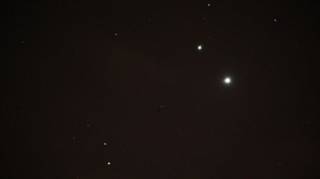
Venus, Jupiter and Mars can be seen this week on the horizon in what is considered a rare grouping of three planets.
The planetary conjunction, in which the planets seem closer together by their positions on the Sun, is visible for days and remain so at least until the end of the week.
The best time to see the planets is just before dawn and are expected to appear very next Thursday.
The next time the planets will be so close will be in January 2021.
But how can the “amateur astronomers” enjoy this show?
How do I see the planets?
The planets can be seen without special equipment if you look to the east.
The best time to see them is just before dawn because at that time the planets are high in the sky is still dark enough to differentiate them.
You can use binoculars and telescopes to view planets in more detail.
What planet is which?
The planet easier to see and which appears larger, is Venus, which is about 12 times brighter than Jupiter, which is seen as the second largest.
Mars is the fuzzy planet in the sky and some 250 times less bright than Venus.
To view Mars, it may be necessary to get up an hour before dawn.
Where I can see them?
Wherever there are clear skies.
The place you are in the world does not affect the way the planets appear.
How long will the phenomenon?
The planets have been together since last October 23 and will remain visible until the end of this week, according Affelia Wibisono, an astronomer at the Royal Observatory in Greenwich says.
It is expected that the planets appear as close as possible on Thursday or Friday.
Still will see Mars and Venus together until next month but not Jupiter.
Is it unusual to a group like this?
Two planets come together in this way throughout the year but is much more rare to see three planets grouped.
The fact that the planets can be seen without binoculars or a telescope is one of the things that makes this phenomenon is especially explained Wibisono discontinued.
By contrast, in Australia it would not be possible to see a group of Uranus, Neptune and Saturn without special equipment.
Why are gathering planets?
The grouping occurs randomly, says Sam Lindsay, assistant editor of Astrophysics of the British Royal Astronomical Society.
The planets follow its own orbit around the Sun, it takes different amounts of time, and have reached a point where they are aligned with the horizon of the Earth.
Are the planets closer?
No.
In fact, the planets are still millions of kilometers between them.
They appear united in their position relative to the Sun, which acts as a torch that lights, and it is not possible to appreciate the depth of space from Earth.
No comments:
Post a Comment